Case Study: Patient with Septic Shock, Treatment Plan
VerifiedAdded on 2023/06/05
|8
|2409
|366
Case Study
AI Summary
This case study analyzes the health condition of a patient diagnosed with septic shock, a life-threatening condition resulting from the body's inflammatory response to infection. The study includes a review of the patient's symptoms, diagnostic results (neutrophil accumulation, ECG, Glasgow Coma Scale), and the rationale behind these findings. The paper suggests a comprehensive treatment plan, emphasizing the importance of hospital admission, antimicrobial therapy, and resuscitation through the control of hypoxia, hypoperfusion, and hypotension. The study also highlights the priority of clinical care based on the Surviving Sepsis Campaign guidelines, including fluid management, and the need for interventions such as IV antibiotics, oxygen support, and infection prevention. Nursing interventions are detailed, including patient observation, infection source identification, and patient education. The conclusion underscores the necessity of a multidisciplinary approach to sepsis management, emphasizing the crucial role of nurses in early detection, diagnosis, and effective treatment to reduce mortality rates, in line with current international guidelines.
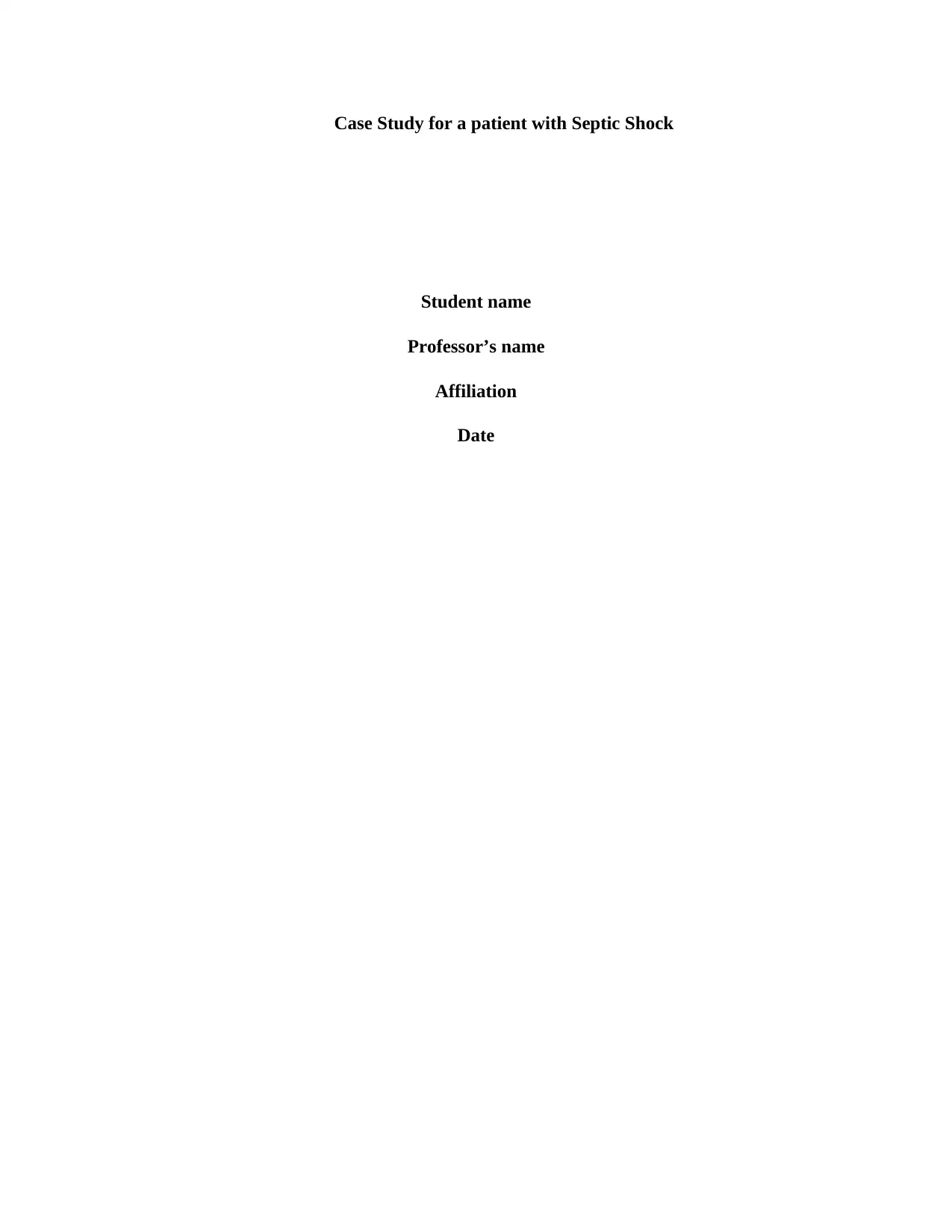
Case Study for a patient with Septic Shock
Student name
Professor’s name
Affiliation
Date
Student name
Professor’s name
Affiliation
Date
Paraphrase This Document
Need a fresh take? Get an instant paraphrase of this document with our AI Paraphraser
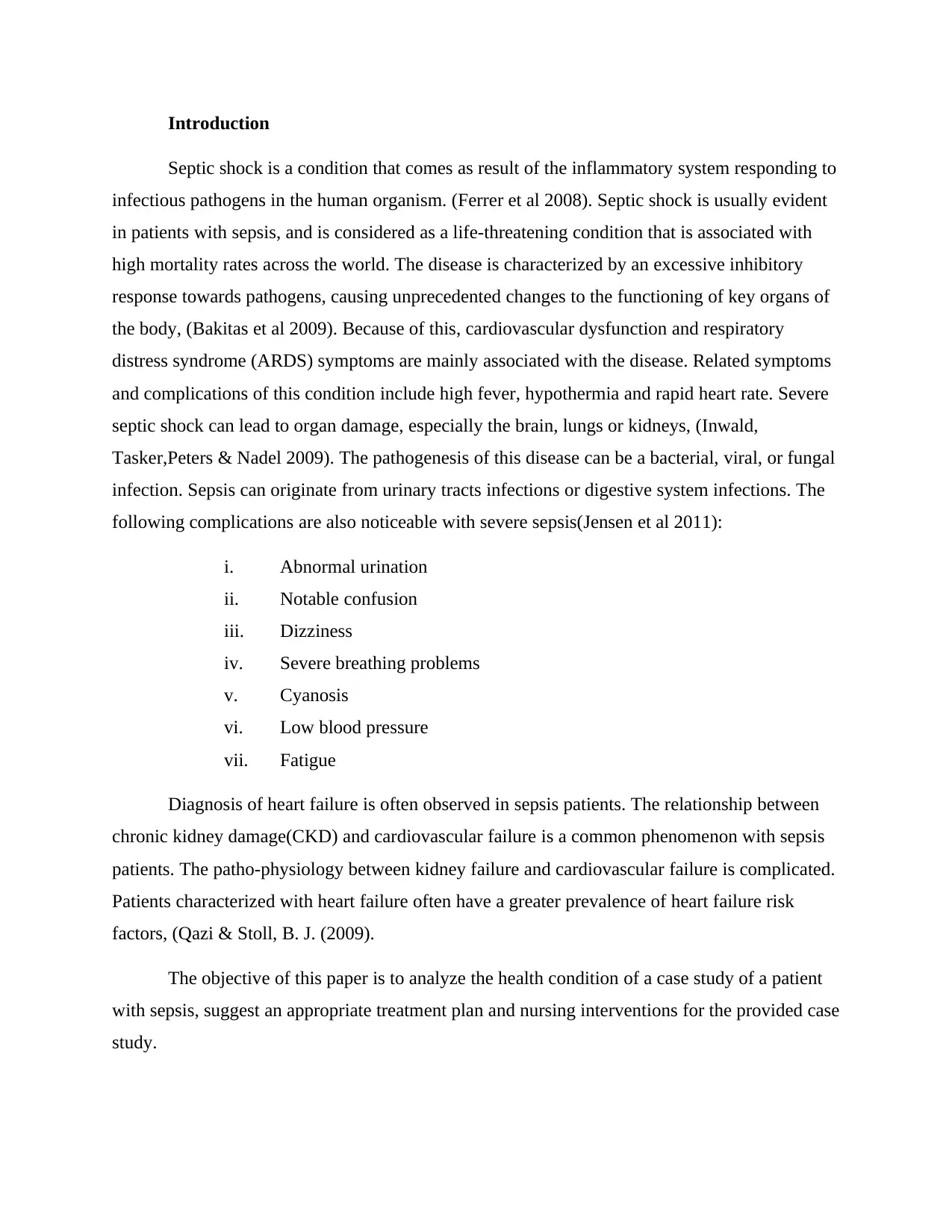
Introduction
Septic shock is a condition that comes as result of the inflammatory system responding to
infectious pathogens in the human organism. (Ferrer et al 2008). Septic shock is usually evident
in patients with sepsis, and is considered as a life-threatening condition that is associated with
high mortality rates across the world. The disease is characterized by an excessive inhibitory
response towards pathogens, causing unprecedented changes to the functioning of key organs of
the body, (Bakitas et al 2009). Because of this, cardiovascular dysfunction and respiratory
distress syndrome (ARDS) symptoms are mainly associated with the disease. Related symptoms
and complications of this condition include high fever, hypothermia and rapid heart rate. Severe
septic shock can lead to organ damage, especially the brain, lungs or kidneys, (Inwald,
Tasker,Peters & Nadel 2009). The pathogenesis of this disease can be a bacterial, viral, or fungal
infection. Sepsis can originate from urinary tracts infections or digestive system infections. The
following complications are also noticeable with severe sepsis(Jensen et al 2011):
i. Abnormal urination
ii. Notable confusion
iii. Dizziness
iv. Severe breathing problems
v. Cyanosis
vi. Low blood pressure
vii. Fatigue
Diagnosis of heart failure is often observed in sepsis patients. The relationship between
chronic kidney damage(CKD) and cardiovascular failure is a common phenomenon with sepsis
patients. The patho-physiology between kidney failure and cardiovascular failure is complicated.
Patients characterized with heart failure often have a greater prevalence of heart failure risk
factors, (Qazi & Stoll, B. J. (2009).
The objective of this paper is to analyze the health condition of a case study of a patient
with sepsis, suggest an appropriate treatment plan and nursing interventions for the provided case
study.
Septic shock is a condition that comes as result of the inflammatory system responding to
infectious pathogens in the human organism. (Ferrer et al 2008). Septic shock is usually evident
in patients with sepsis, and is considered as a life-threatening condition that is associated with
high mortality rates across the world. The disease is characterized by an excessive inhibitory
response towards pathogens, causing unprecedented changes to the functioning of key organs of
the body, (Bakitas et al 2009). Because of this, cardiovascular dysfunction and respiratory
distress syndrome (ARDS) symptoms are mainly associated with the disease. Related symptoms
and complications of this condition include high fever, hypothermia and rapid heart rate. Severe
septic shock can lead to organ damage, especially the brain, lungs or kidneys, (Inwald,
Tasker,Peters & Nadel 2009). The pathogenesis of this disease can be a bacterial, viral, or fungal
infection. Sepsis can originate from urinary tracts infections or digestive system infections. The
following complications are also noticeable with severe sepsis(Jensen et al 2011):
i. Abnormal urination
ii. Notable confusion
iii. Dizziness
iv. Severe breathing problems
v. Cyanosis
vi. Low blood pressure
vii. Fatigue
Diagnosis of heart failure is often observed in sepsis patients. The relationship between
chronic kidney damage(CKD) and cardiovascular failure is a common phenomenon with sepsis
patients. The patho-physiology between kidney failure and cardiovascular failure is complicated.
Patients characterized with heart failure often have a greater prevalence of heart failure risk
factors, (Qazi & Stoll, B. J. (2009).
The objective of this paper is to analyze the health condition of a case study of a patient
with sepsis, suggest an appropriate treatment plan and nursing interventions for the provided case
study.
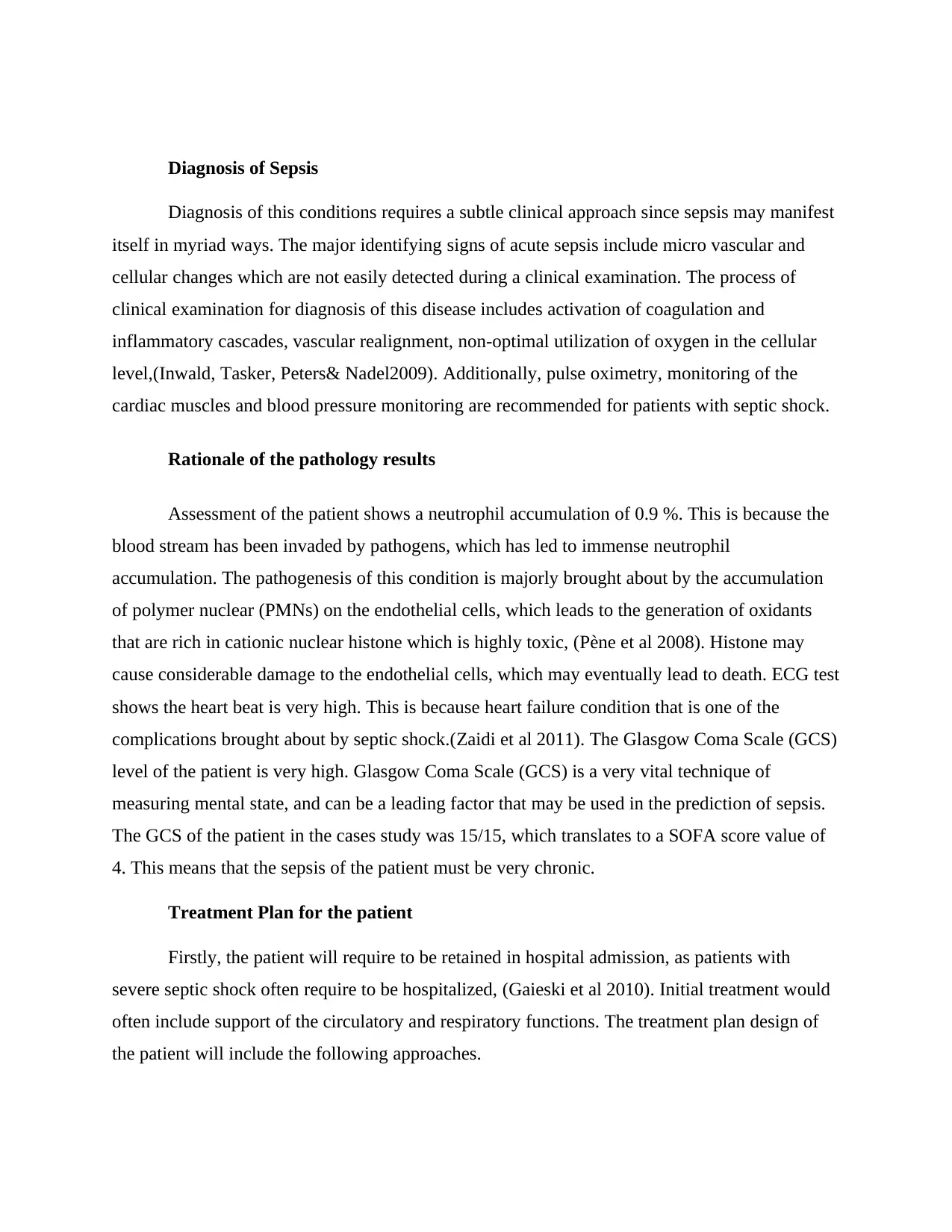
Diagnosis of Sepsis
Diagnosis of this conditions requires a subtle clinical approach since sepsis may manifest
itself in myriad ways. The major identifying signs of acute sepsis include micro vascular and
cellular changes which are not easily detected during a clinical examination. The process of
clinical examination for diagnosis of this disease includes activation of coagulation and
inflammatory cascades, vascular realignment, non-optimal utilization of oxygen in the cellular
level,(Inwald, Tasker, Peters& Nadel2009). Additionally, pulse oximetry, monitoring of the
cardiac muscles and blood pressure monitoring are recommended for patients with septic shock.
Rationale of the pathology results
Assessment of the patient shows a neutrophil accumulation of 0.9 %. This is because the
blood stream has been invaded by pathogens, which has led to immense neutrophil
accumulation. The pathogenesis of this condition is majorly brought about by the accumulation
of polymer nuclear (PMNs) on the endothelial cells, which leads to the generation of oxidants
that are rich in cationic nuclear histone which is highly toxic, (Pène et al 2008). Histone may
cause considerable damage to the endothelial cells, which may eventually lead to death. ECG test
shows the heart beat is very high. This is because heart failure condition that is one of the
complications brought about by septic shock.(Zaidi et al 2011). The Glasgow Coma Scale (GCS)
level of the patient is very high. Glasgow Coma Scale (GCS) is a very vital technique of
measuring mental state, and can be a leading factor that may be used in the prediction of sepsis.
The GCS of the patient in the cases study was 15/15, which translates to a SOFA score value of
4. This means that the sepsis of the patient must be very chronic.
Treatment Plan for the patient
Firstly, the patient will require to be retained in hospital admission, as patients with
severe septic shock often require to be hospitalized, (Gaieski et al 2010). Initial treatment would
often include support of the circulatory and respiratory functions. The treatment plan design of
the patient will include the following approaches.
Diagnosis of this conditions requires a subtle clinical approach since sepsis may manifest
itself in myriad ways. The major identifying signs of acute sepsis include micro vascular and
cellular changes which are not easily detected during a clinical examination. The process of
clinical examination for diagnosis of this disease includes activation of coagulation and
inflammatory cascades, vascular realignment, non-optimal utilization of oxygen in the cellular
level,(Inwald, Tasker, Peters& Nadel2009). Additionally, pulse oximetry, monitoring of the
cardiac muscles and blood pressure monitoring are recommended for patients with septic shock.
Rationale of the pathology results
Assessment of the patient shows a neutrophil accumulation of 0.9 %. This is because the
blood stream has been invaded by pathogens, which has led to immense neutrophil
accumulation. The pathogenesis of this condition is majorly brought about by the accumulation
of polymer nuclear (PMNs) on the endothelial cells, which leads to the generation of oxidants
that are rich in cationic nuclear histone which is highly toxic, (Pène et al 2008). Histone may
cause considerable damage to the endothelial cells, which may eventually lead to death. ECG test
shows the heart beat is very high. This is because heart failure condition that is one of the
complications brought about by septic shock.(Zaidi et al 2011). The Glasgow Coma Scale (GCS)
level of the patient is very high. Glasgow Coma Scale (GCS) is a very vital technique of
measuring mental state, and can be a leading factor that may be used in the prediction of sepsis.
The GCS of the patient in the cases study was 15/15, which translates to a SOFA score value of
4. This means that the sepsis of the patient must be very chronic.
Treatment Plan for the patient
Firstly, the patient will require to be retained in hospital admission, as patients with
severe septic shock often require to be hospitalized, (Gaieski et al 2010). Initial treatment would
often include support of the circulatory and respiratory functions. The treatment plan design of
the patient will include the following approaches.
⊘ This is a preview!⊘
Do you want full access?
Subscribe today to unlock all pages.

Trusted by 1+ million students worldwide
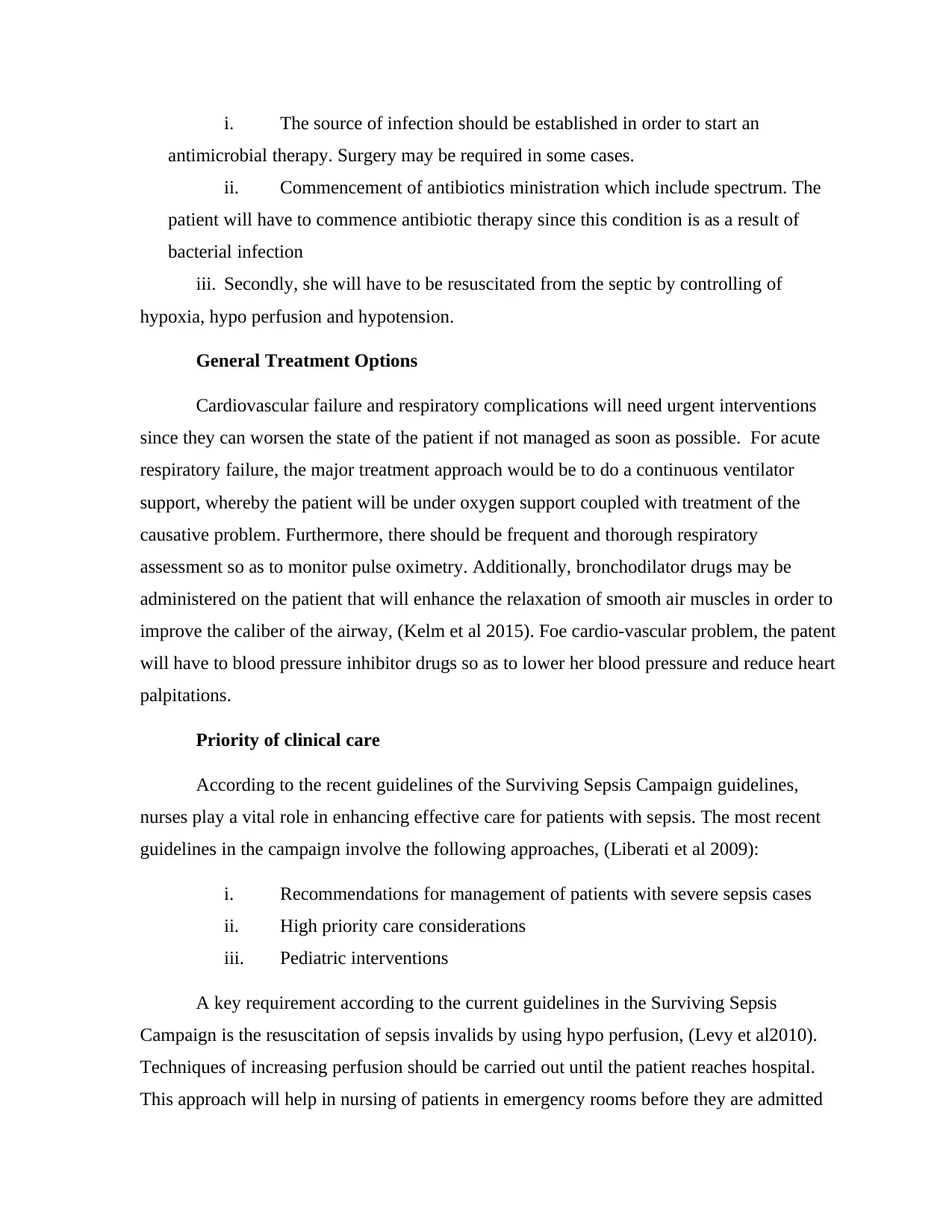
i. The source of infection should be established in order to start an
antimicrobial therapy. Surgery may be required in some cases.
ii. Commencement of antibiotics ministration which include spectrum. The
patient will have to commence antibiotic therapy since this condition is as a result of
bacterial infection
iii. Secondly, she will have to be resuscitated from the septic by controlling of
hypoxia, hypo perfusion and hypotension.
General Treatment Options
Cardiovascular failure and respiratory complications will need urgent interventions
since they can worsen the state of the patient if not managed as soon as possible. For acute
respiratory failure, the major treatment approach would be to do a continuous ventilator
support, whereby the patient will be under oxygen support coupled with treatment of the
causative problem. Furthermore, there should be frequent and thorough respiratory
assessment so as to monitor pulse oximetry. Additionally, bronchodilator drugs may be
administered on the patient that will enhance the relaxation of smooth air muscles in order to
improve the caliber of the airway, (Kelm et al 2015). Foe cardio-vascular problem, the patent
will have to blood pressure inhibitor drugs so as to lower her blood pressure and reduce heart
palpitations.
Priority of clinical care
According to the recent guidelines of the Surviving Sepsis Campaign guidelines,
nurses play a vital role in enhancing effective care for patients with sepsis. The most recent
guidelines in the campaign involve the following approaches, (Liberati et al 2009):
i. Recommendations for management of patients with severe sepsis cases
ii. High priority care considerations
iii. Pediatric interventions
A key requirement according to the current guidelines in the Surviving Sepsis
Campaign is the resuscitation of sepsis invalids by using hypo perfusion, (Levy et al2010).
Techniques of increasing perfusion should be carried out until the patient reaches hospital.
This approach will help in nursing of patients in emergency rooms before they are admitted
antimicrobial therapy. Surgery may be required in some cases.
ii. Commencement of antibiotics ministration which include spectrum. The
patient will have to commence antibiotic therapy since this condition is as a result of
bacterial infection
iii. Secondly, she will have to be resuscitated from the septic by controlling of
hypoxia, hypo perfusion and hypotension.
General Treatment Options
Cardiovascular failure and respiratory complications will need urgent interventions
since they can worsen the state of the patient if not managed as soon as possible. For acute
respiratory failure, the major treatment approach would be to do a continuous ventilator
support, whereby the patient will be under oxygen support coupled with treatment of the
causative problem. Furthermore, there should be frequent and thorough respiratory
assessment so as to monitor pulse oximetry. Additionally, bronchodilator drugs may be
administered on the patient that will enhance the relaxation of smooth air muscles in order to
improve the caliber of the airway, (Kelm et al 2015). Foe cardio-vascular problem, the patent
will have to blood pressure inhibitor drugs so as to lower her blood pressure and reduce heart
palpitations.
Priority of clinical care
According to the recent guidelines of the Surviving Sepsis Campaign guidelines,
nurses play a vital role in enhancing effective care for patients with sepsis. The most recent
guidelines in the campaign involve the following approaches, (Liberati et al 2009):
i. Recommendations for management of patients with severe sepsis cases
ii. High priority care considerations
iii. Pediatric interventions
A key requirement according to the current guidelines in the Surviving Sepsis
Campaign is the resuscitation of sepsis invalids by using hypo perfusion, (Levy et al2010).
Techniques of increasing perfusion should be carried out until the patient reaches hospital.
This approach will help in nursing of patients in emergency rooms before they are admitted
Paraphrase This Document
Need a fresh take? Get an instant paraphrase of this document with our AI Paraphraser

to the ICU. The Surviving Sepsis Campaign guidelines require that sepsis induced hyper
pofusion for the first six hours should include the following (Rivers et al 2012):
i. Venous pressure (8–12 mm Hg).
ii. Output of urine (≥0.5 mL/kg per hour).
iii. Oxygen saturation 65%
Management of the patient
Management of the patient will include the following approaches:
I. Observation and assessment of the patient. The patient should be regularly
assessed for indications of vital signs and monitoring of output of urine each hour.
II. Establishment of cause of infection. The patient should be thoroughly
examined I order to identify the source of her infection that has caused the septic shock.
Should the cause be identified, immediate action should be taken that is geared to
eliminating the disease. Additionally, surgery to remove the infected tissue or for
drainage of necrotic bowel may be necessary.
III. In case the patient gets worse, referral to HDU or ICU may also be
necessary.
Nursing Interventions for Sepsis
i. Administration of IV antibiotics
Before the administration of antibiotics, measures should be put forth to establish the
cause of the infection. After that, commencement of antibiotic therapies may be required.
ii. Optimization of fluid –volume stats
Sepsis patients often are I need of an immense fluid resuscitation.
iii. Assess and monitoring of the oxygen consumption
It is often the case that patients of sepsis require oxygen support ventilations, according
to the severity of the condition.
iv. Infection Prevention
pofusion for the first six hours should include the following (Rivers et al 2012):
i. Venous pressure (8–12 mm Hg).
ii. Output of urine (≥0.5 mL/kg per hour).
iii. Oxygen saturation 65%
Management of the patient
Management of the patient will include the following approaches:
I. Observation and assessment of the patient. The patient should be regularly
assessed for indications of vital signs and monitoring of output of urine each hour.
II. Establishment of cause of infection. The patient should be thoroughly
examined I order to identify the source of her infection that has caused the septic shock.
Should the cause be identified, immediate action should be taken that is geared to
eliminating the disease. Additionally, surgery to remove the infected tissue or for
drainage of necrotic bowel may be necessary.
III. In case the patient gets worse, referral to HDU or ICU may also be
necessary.
Nursing Interventions for Sepsis
i. Administration of IV antibiotics
Before the administration of antibiotics, measures should be put forth to establish the
cause of the infection. After that, commencement of antibiotic therapies may be required.
ii. Optimization of fluid –volume stats
Sepsis patients often are I need of an immense fluid resuscitation.
iii. Assess and monitoring of the oxygen consumption
It is often the case that patients of sepsis require oxygen support ventilations, according
to the severity of the condition.
iv. Infection Prevention
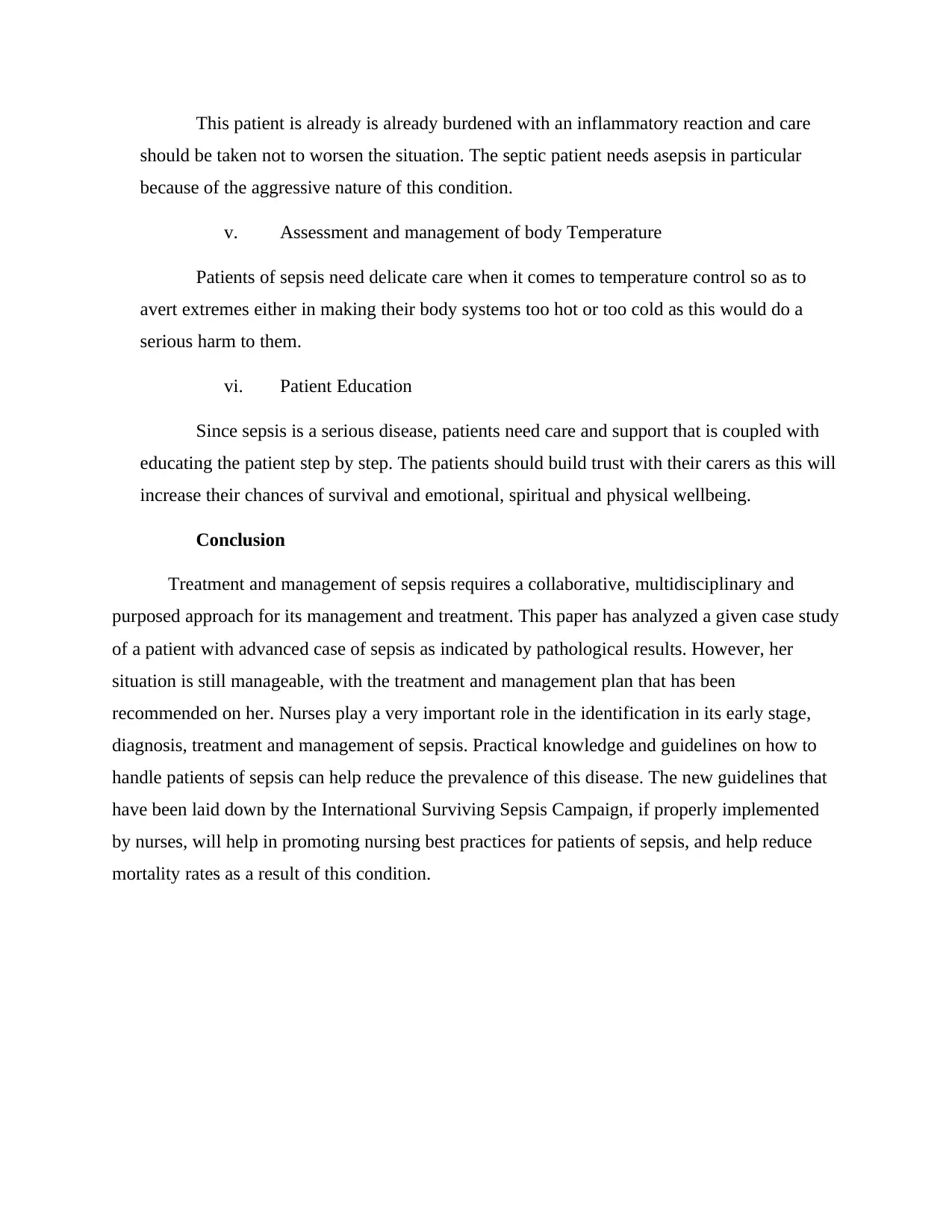
This patient is already is already burdened with an inflammatory reaction and care
should be taken not to worsen the situation. The septic patient needs asepsis in particular
because of the aggressive nature of this condition.
v. Assessment and management of body Temperature
Patients of sepsis need delicate care when it comes to temperature control so as to
avert extremes either in making their body systems too hot or too cold as this would do a
serious harm to them.
vi. Patient Education
Since sepsis is a serious disease, patients need care and support that is coupled with
educating the patient step by step. The patients should build trust with their carers as this will
increase their chances of survival and emotional, spiritual and physical wellbeing.
Conclusion
Treatment and management of sepsis requires a collaborative, multidisciplinary and
purposed approach for its management and treatment. This paper has analyzed a given case study
of a patient with advanced case of sepsis as indicated by pathological results. However, her
situation is still manageable, with the treatment and management plan that has been
recommended on her. Nurses play a very important role in the identification in its early stage,
diagnosis, treatment and management of sepsis. Practical knowledge and guidelines on how to
handle patients of sepsis can help reduce the prevalence of this disease. The new guidelines that
have been laid down by the International Surviving Sepsis Campaign, if properly implemented
by nurses, will help in promoting nursing best practices for patients of sepsis, and help reduce
mortality rates as a result of this condition.
should be taken not to worsen the situation. The septic patient needs asepsis in particular
because of the aggressive nature of this condition.
v. Assessment and management of body Temperature
Patients of sepsis need delicate care when it comes to temperature control so as to
avert extremes either in making their body systems too hot or too cold as this would do a
serious harm to them.
vi. Patient Education
Since sepsis is a serious disease, patients need care and support that is coupled with
educating the patient step by step. The patients should build trust with their carers as this will
increase their chances of survival and emotional, spiritual and physical wellbeing.
Conclusion
Treatment and management of sepsis requires a collaborative, multidisciplinary and
purposed approach for its management and treatment. This paper has analyzed a given case study
of a patient with advanced case of sepsis as indicated by pathological results. However, her
situation is still manageable, with the treatment and management plan that has been
recommended on her. Nurses play a very important role in the identification in its early stage,
diagnosis, treatment and management of sepsis. Practical knowledge and guidelines on how to
handle patients of sepsis can help reduce the prevalence of this disease. The new guidelines that
have been laid down by the International Surviving Sepsis Campaign, if properly implemented
by nurses, will help in promoting nursing best practices for patients of sepsis, and help reduce
mortality rates as a result of this condition.
⊘ This is a preview!⊘
Do you want full access?
Subscribe today to unlock all pages.

Trusted by 1+ million students worldwide
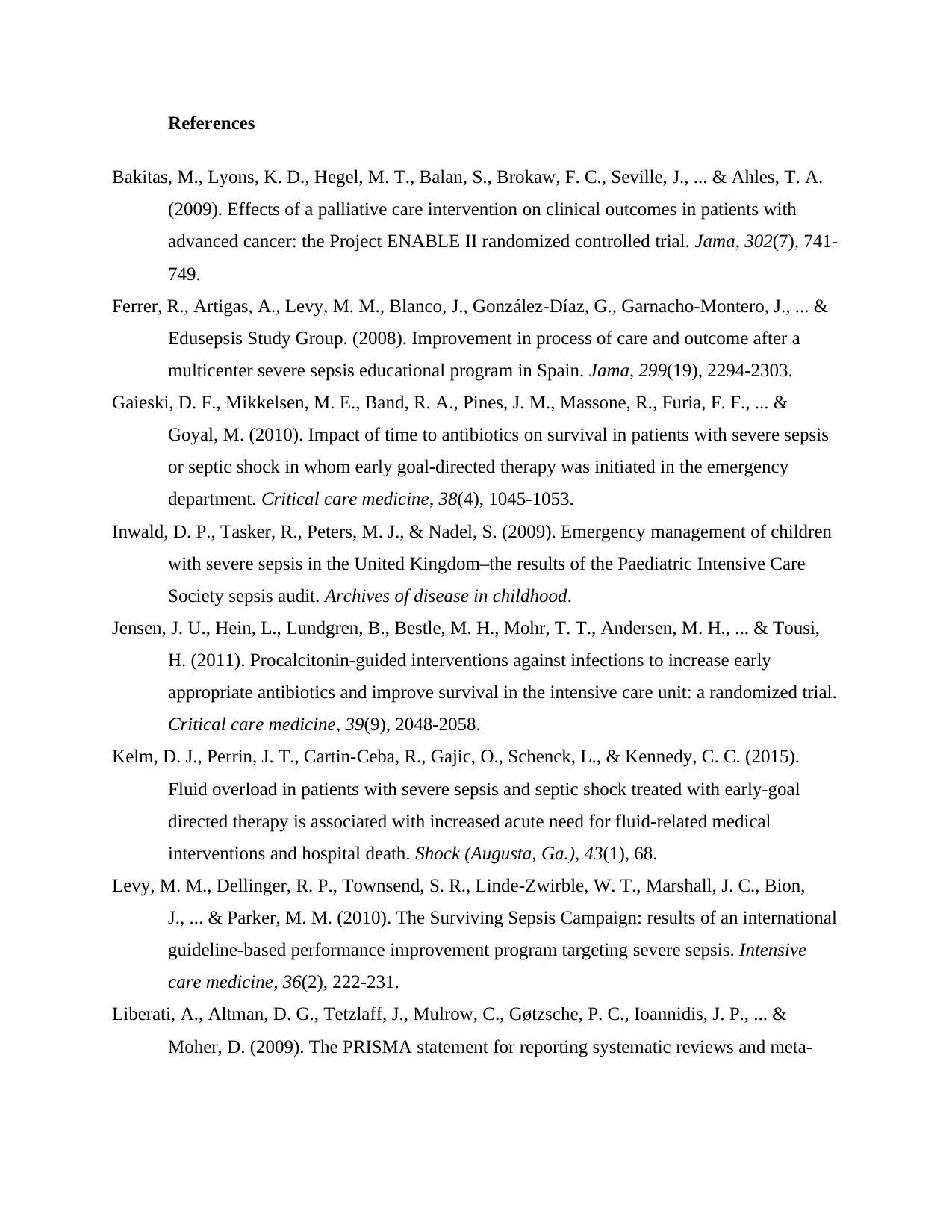
References
Bakitas, M., Lyons, K. D., Hegel, M. T., Balan, S., Brokaw, F. C., Seville, J., ... & Ahles, T. A.
(2009). Effects of a palliative care intervention on clinical outcomes in patients with
advanced cancer: the Project ENABLE II randomized controlled trial. Jama, 302(7), 741-
749.
Ferrer, R., Artigas, A., Levy, M. M., Blanco, J., González-Díaz, G., Garnacho-Montero, J., ... &
Edusepsis Study Group. (2008). Improvement in process of care and outcome after a
multicenter severe sepsis educational program in Spain. Jama, 299(19), 2294-2303.
Gaieski, D. F., Mikkelsen, M. E., Band, R. A., Pines, J. M., Massone, R., Furia, F. F., ... &
Goyal, M. (2010). Impact of time to antibiotics on survival in patients with severe sepsis
or septic shock in whom early goal-directed therapy was initiated in the emergency
department. Critical care medicine, 38(4), 1045-1053.
Inwald, D. P., Tasker, R., Peters, M. J., & Nadel, S. (2009). Emergency management of children
with severe sepsis in the United Kingdom–the results of the Paediatric Intensive Care
Society sepsis audit. Archives of disease in childhood.
Jensen, J. U., Hein, L., Lundgren, B., Bestle, M. H., Mohr, T. T., Andersen, M. H., ... & Tousi,
H. (2011). Procalcitonin-guided interventions against infections to increase early
appropriate antibiotics and improve survival in the intensive care unit: a randomized trial.
Critical care medicine, 39(9), 2048-2058.
Kelm, D. J., Perrin, J. T., Cartin-Ceba, R., Gajic, O., Schenck, L., & Kennedy, C. C. (2015).
Fluid overload in patients with severe sepsis and septic shock treated with early-goal
directed therapy is associated with increased acute need for fluid-related medical
interventions and hospital death. Shock (Augusta, Ga.), 43(1), 68.
Levy, M. M., Dellinger, R. P., Townsend, S. R., Linde-Zwirble, W. T., Marshall, J. C., Bion,
J., ... & Parker, M. M. (2010). The Surviving Sepsis Campaign: results of an international
guideline-based performance improvement program targeting severe sepsis. Intensive
care medicine, 36(2), 222-231.
Liberati, A., Altman, D. G., Tetzlaff, J., Mulrow, C., Gøtzsche, P. C., Ioannidis, J. P., ... &
Moher, D. (2009). The PRISMA statement for reporting systematic reviews and meta-
Bakitas, M., Lyons, K. D., Hegel, M. T., Balan, S., Brokaw, F. C., Seville, J., ... & Ahles, T. A.
(2009). Effects of a palliative care intervention on clinical outcomes in patients with
advanced cancer: the Project ENABLE II randomized controlled trial. Jama, 302(7), 741-
749.
Ferrer, R., Artigas, A., Levy, M. M., Blanco, J., González-Díaz, G., Garnacho-Montero, J., ... &
Edusepsis Study Group. (2008). Improvement in process of care and outcome after a
multicenter severe sepsis educational program in Spain. Jama, 299(19), 2294-2303.
Gaieski, D. F., Mikkelsen, M. E., Band, R. A., Pines, J. M., Massone, R., Furia, F. F., ... &
Goyal, M. (2010). Impact of time to antibiotics on survival in patients with severe sepsis
or septic shock in whom early goal-directed therapy was initiated in the emergency
department. Critical care medicine, 38(4), 1045-1053.
Inwald, D. P., Tasker, R., Peters, M. J., & Nadel, S. (2009). Emergency management of children
with severe sepsis in the United Kingdom–the results of the Paediatric Intensive Care
Society sepsis audit. Archives of disease in childhood.
Jensen, J. U., Hein, L., Lundgren, B., Bestle, M. H., Mohr, T. T., Andersen, M. H., ... & Tousi,
H. (2011). Procalcitonin-guided interventions against infections to increase early
appropriate antibiotics and improve survival in the intensive care unit: a randomized trial.
Critical care medicine, 39(9), 2048-2058.
Kelm, D. J., Perrin, J. T., Cartin-Ceba, R., Gajic, O., Schenck, L., & Kennedy, C. C. (2015).
Fluid overload in patients with severe sepsis and septic shock treated with early-goal
directed therapy is associated with increased acute need for fluid-related medical
interventions and hospital death. Shock (Augusta, Ga.), 43(1), 68.
Levy, M. M., Dellinger, R. P., Townsend, S. R., Linde-Zwirble, W. T., Marshall, J. C., Bion,
J., ... & Parker, M. M. (2010). The Surviving Sepsis Campaign: results of an international
guideline-based performance improvement program targeting severe sepsis. Intensive
care medicine, 36(2), 222-231.
Liberati, A., Altman, D. G., Tetzlaff, J., Mulrow, C., Gøtzsche, P. C., Ioannidis, J. P., ... &
Moher, D. (2009). The PRISMA statement for reporting systematic reviews and meta-
Paraphrase This Document
Need a fresh take? Get an instant paraphrase of this document with our AI Paraphraser
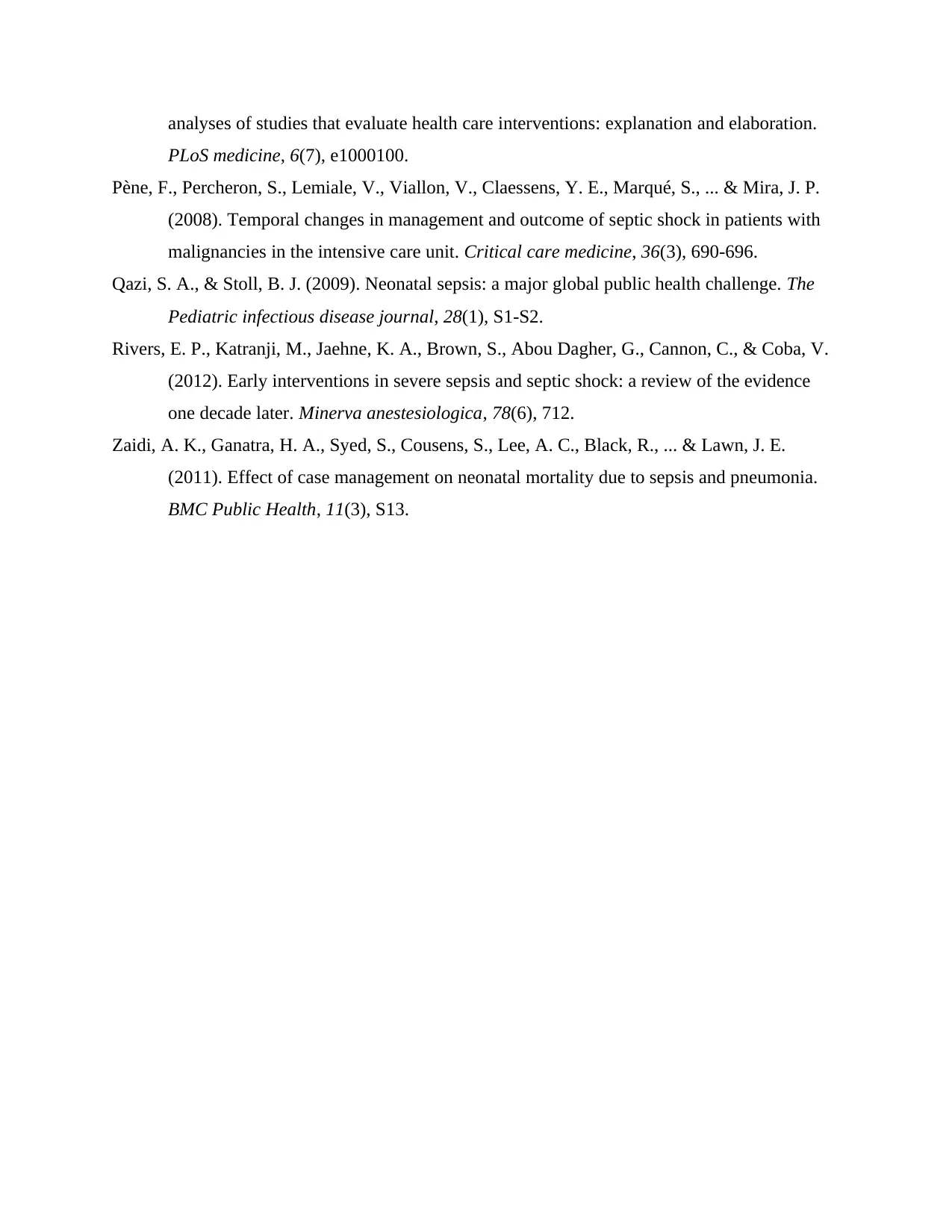
analyses of studies that evaluate health care interventions: explanation and elaboration.
PLoS medicine, 6(7), e1000100.
Pène, F., Percheron, S., Lemiale, V., Viallon, V., Claessens, Y. E., Marqué, S., ... & Mira, J. P.
(2008). Temporal changes in management and outcome of septic shock in patients with
malignancies in the intensive care unit. Critical care medicine, 36(3), 690-696.
Qazi, S. A., & Stoll, B. J. (2009). Neonatal sepsis: a major global public health challenge. The
Pediatric infectious disease journal, 28(1), S1-S2.
Rivers, E. P., Katranji, M., Jaehne, K. A., Brown, S., Abou Dagher, G., Cannon, C., & Coba, V.
(2012). Early interventions in severe sepsis and septic shock: a review of the evidence
one decade later. Minerva anestesiologica, 78(6), 712.
Zaidi, A. K., Ganatra, H. A., Syed, S., Cousens, S., Lee, A. C., Black, R., ... & Lawn, J. E.
(2011). Effect of case management on neonatal mortality due to sepsis and pneumonia.
BMC Public Health, 11(3), S13.
PLoS medicine, 6(7), e1000100.
Pène, F., Percheron, S., Lemiale, V., Viallon, V., Claessens, Y. E., Marqué, S., ... & Mira, J. P.
(2008). Temporal changes in management and outcome of septic shock in patients with
malignancies in the intensive care unit. Critical care medicine, 36(3), 690-696.
Qazi, S. A., & Stoll, B. J. (2009). Neonatal sepsis: a major global public health challenge. The
Pediatric infectious disease journal, 28(1), S1-S2.
Rivers, E. P., Katranji, M., Jaehne, K. A., Brown, S., Abou Dagher, G., Cannon, C., & Coba, V.
(2012). Early interventions in severe sepsis and septic shock: a review of the evidence
one decade later. Minerva anestesiologica, 78(6), 712.
Zaidi, A. K., Ganatra, H. A., Syed, S., Cousens, S., Lee, A. C., Black, R., ... & Lawn, J. E.
(2011). Effect of case management on neonatal mortality due to sepsis and pneumonia.
BMC Public Health, 11(3), S13.
1 out of 8
Related Documents
Your All-in-One AI-Powered Toolkit for Academic Success.
+13062052269
info@desklib.com
Available 24*7 on WhatsApp / Email
![[object Object]](/_next/static/media/star-bottom.7253800d.svg)
Unlock your academic potential
Copyright © 2020–2025 A2Z Services. All Rights Reserved. Developed and managed by ZUCOL.





